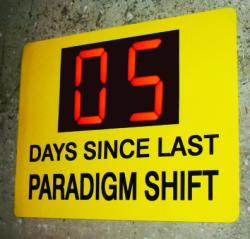if the system is broke...
"Frameworks must be lived with and explored before they can be broken."
I've held back from posting over the last week given the ongoing political upheaval back home and the aftermath of Katrina in the U.S,
Both events are painful examples of failures in systems. By saying that, I am not absolving anyone of blame or complicity, simply that meaningful changes to systems rarely equate down the the replacement of a single individidual.
I am a veteran of both EDSA I and II and though each event produced the change we wanted to effect - replacing a corrupt leader - each failed to change the system for the good. Though we found the tipping point necessary to reset the political clock, the change point did not significantly affect the deeper (faulty) mechanisms of our society.
That points me to systems thinking, particularly to the late Dana Meadow who identified Twelve Leverage Points to Intervene in a System (pdf 91kb). I reproduce part of the summary from the Wikipedia page below:
Leverage points to intervene in a system
(in increasing order of effectiveness)
- 12. Constants, parameters, numbers (such as subsidies, taxes, standards)
- Parameters are points of lowest leverage effects. Though they are the most clearly perceived among all leverages, they have little effect long term; they do not usually change behaviors. A widely changing system will not be made stable by a change of parameter, nor will a stagnant one dramatically change.
- 11. The size of buffers and other stabilizing stocks, relative to their flows
- A buffer is a stabilizing stock. The stabilizing buffer is important when the stock amount is much higher than the potential amount of inflows or outflows. In the lake, the volume of water in the lake is the buffer: if there's a lot more of it than inflow/outflow, the system stays stable.
- 10. The structure of material stocks and flows (such as transport network, population age structures)
- The structure of the system may have enormous effect on how the system operates. So it might also be a leverage point to act on. However, if a system structure was not built properly, the cost, delays and externalities of the rebuilding may be prohibitive. Sometimes, the structure cannot even be changed at all. So the leverage point might be to understand the system limitations and bottlenecks, and to work on fluctuations.
- 9. The length of delays, relative to the rate of system changes
- Another leverage point is in the length of delays. Delays must be carefully considered, as information received too quickly or information received too late could cause either overreaction and underreaction. Very lengthy delays cause oscillations when trying to adjust a system. However, delays are often parameters that can be changed as easily as rate of change.
- 8. The strength of negative feedback loops, relative to the effect they are trying to correct against
- A negative feedback loop is a control that tend to slow down a process (it refers to the direction of the change). In a system going forward, the negative loop will tend to promote stability (stagnation). The loop will keep the stock near the goal, thanks to parameters, accuracy and speed of information feedback, and size of correcting flows.
- 7. The gain around driving positive feedback loops
- A positive feedback loop is a control that tends to speed up a process (it refers to the direction of the change). It is a self-reinforcing loop. Positive feedback loop are sources of growth, of explosion, and sometimes of collapse when the feedback is not under control (in particular of a negative feedback loop). Dana indicates that in most cases, it is preferable to slow down a positive loop, rather than speeding up a negative one.
- 6. The structure of information flow (who does and does not have access to what kinds of information)
- Information flow is a very important leverage point in a system. It is neither a parameter, nor a re-inforcing or slowing loop, but a new loop delivering information that was not delivered before. It is considered a very powerful leverage, cheaper and easier than infrastructure change.
- 5. The rules of the system (such as incentives, punishment, constraints)
- Rules are very high leverage points. Dana Meadows points out the importance of paying attention to rules, and mostly to who make them.
- 4. The power to add, change, evolve, or self-organize system structure
- Self-organization refers to the capacity of a system to change itself by creating new structures; adding new negative and positive feedback loops, promoting new information flows, making new rules.
- 3. The goal of the system
- A goal change has effect on every item listed above, parameters, feedback loops, information and self-organisation.
- 2. The mindset or paradigm that the system — its goals, structure, rules, delays, parameters — arises out of
- A society paradigm is an idea, an unstated assumption (because it is unnecessary to state it) that everyone shares, thoughts, or states of thoughts that are sources of systems. Any set of assumptions becomes a paradigm, and therefore re-examining all the fundamental assumptions may lead to new paradigms. Paradigms are very hard to change, but there are no limits to paradigm change. It just requires another way of seeing things. Dana indicates paradigms might be changed by repeatedly and consistently pointing out anomalities and failures to those with open minds.
- 1. The power to transcend paradigms
- Transcending paradigms may go beyond challenging fundamental assumptions, into the realm of changing the values and priorities that lead to the assumptions, and being able to choose among value sets at will. The power of this ability may be literally godlike.
More about this next time...


2 comments:
Great post, this one. It's a keeper. I also saved the original from Donella Meadows.
citizen frank
thanks, citizen frank.
Post a Comment